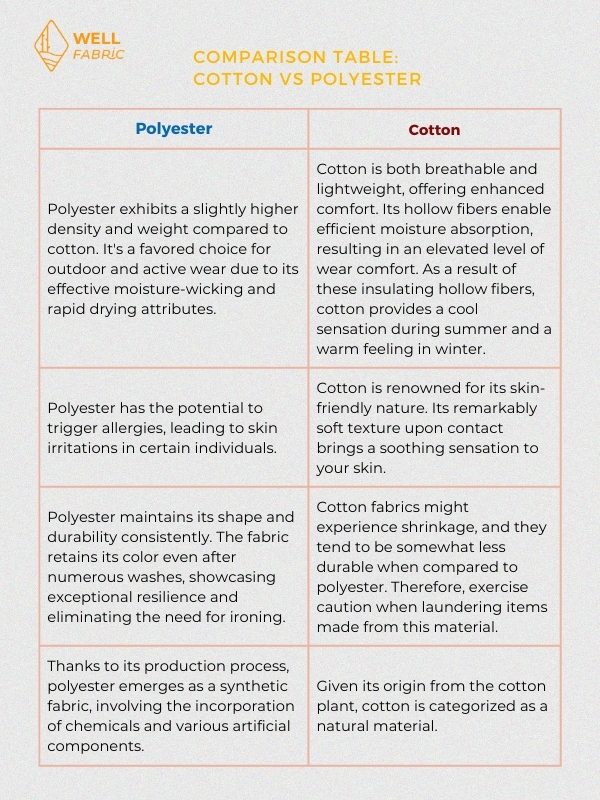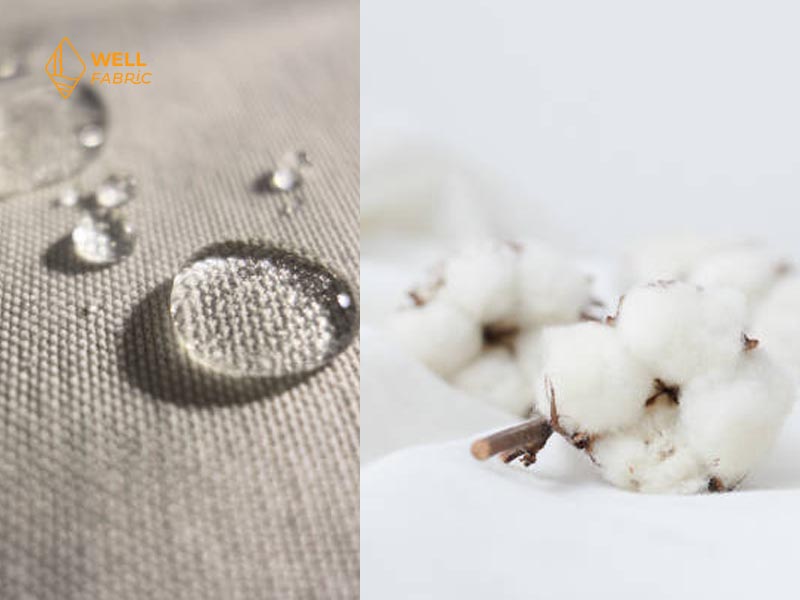In the realm of fashion and textile manufacturing, understanding the differences between these two fabric types has never been more crucial. When pitting Polyester fabric vs cotton, WELL FABRIC believes that each fabric holds distinct attributes, contributing to diversity and consumer choice.
Both fabrics find widespread and diverse applications across the garment industry. From everyday t-shirts to high-end fashion ensembles, Polyester and Cotton contribute to a variety of styles and materials.
Now, let’s delve into the disparities between cotton vs polyester fabric with WELL FABRIC to gain an overview of the merits and limitations of each fabric.
>>>Read more:
- Recycled Polyester vs Cotton: Which Is More Eco-Friendly?
- Comparing Rayon vs Polyester: 4 Key Factors to Consider
- Modal vs Polyester Fabric: Contrasting 13 Key Distinctions
1. Origin and Production Process – Polyester fabric vs cotton
1.1. Polyester Fabric

Chemical Composition and Origin
Polyester Fabric originates from a chemical process, mainly involving compounds like polyethylene terephthalate (PET). This synthetic fiber derives from oil and gas, undergoing a complex chemical processing that transforms PET into polyester fiber, resulting in a distinctive fabric.
Production Process
The production of Polyester Fabric begins with melting the polyester fiber at high temperatures. The molten substance is then extruded through small openings to form continuous fibers, which solidify into high-quality fabric. An outstanding trait of Polyester is its durability, maintaining its original shape even after repeated use and washing.
Durability and Shape Retention
Polyester Fabric stands out for its strength and elasticity. This characteristic ensures the preservation of the fabric’s original form, even in harsh environments or frequent usage. This quality makes Polyester Fabric suitable for products requiring resilience and uniformity in various situations.
1.2. Cotton Fabric

Natural Origin
Cotton Fabric is derived from the natural cotton plant. Cotton fibers are harvested from the cotton bolls and subsequently utilized to craft fabric products. This process creates a fabric that is both familiar and environmentally friendly.
Production Process
Cotton fibers possess a unique feature: hollow gaps along their length. These gaps expand when exposed to water, granting excellent absorbency and breathability to Cotton Fabric. To enhance durability, manufacturers often coat cotton fibers with a natural protective wax layer, rendering them water-resistant.
Absorbency and Breathability
Cotton Fabric is renowned for its excellent absorbency and high breathability. This attribute makes Cotton a popular choice among those seeking comfort and a cool sensation. Its breathability and moisture-retention capabilities also ensure that Cotton Fabric is an excellent option for tropical climates and active endeavors.
From these aspects, we gain an overview of how origin and production processes influence the unique characteristics of Polyester and Cotton Fabrics.
2. Characteristics, Pros and Cons – Polyester Fabric vs Cotton
2.1. Polyester Fabric
Advantages
Polyester fabric stands out for its durability and ability to maintain the original shape of the product. This ensures that clothes and textile products made from polyester do not shrink or deform after extended use. Moreover, polyester fabric is wrinkle-resistant, allowing you to look neat without the need for frequent ironing.
Disadvantages
One of the significant drawbacks of polyester fabric is its lack of breathability and moisture absorption. This means that the fabric cannot absorb sweat or moisture, leading to a damp and uncomfortable feeling over time. Additionally, polyester fabric can cause irritation for sensitive skin, resulting in itchiness and discomfort.
2.2. Cotton Fabric
Advantages
Cotton fabric is beloved for its soft and smooth texture, providing a comfortable wearing experience. The excellent moisture absorption and breathability of cotton help maintain a cool and dry sensation during usage. Notably, cotton fabric is skin-friendly, particularly for sensitive skin types.
Disadvantages
Despite its numerous advantages, cotton fabric also has some limitations. Cotton is prone to wrinkles and may lose its shape after washing, requiring special care to preserve its original form. Furthermore, cotton fabric can fade or lose color after prolonged use and multiple washes.

In conclusion, both polyester fabric and cotton fabric have distinct characteristics and their own set of pros and cons. The choice between these two types of fabrics depends on the intended use and personal preferences of each individual.
3. What is Polyester Blend Cotton? Why Combine these Two Materials?
In the realm of textile and garment manufacturing, the relentless pursuit of innovation and combining materials to create superior products is a top priority. Alongside the choice of 100% cotton fabric, polyester fabric blended with cotton has rapidly emerged as an intriguing and diverse option favored by many. This approach not only reduces costs but also mitigates the limitations of using 100% polyester fabric.
Depending on the specific application, manufacturers determine the appropriate ratio between cotton and polyester fibers. The higher the percentage of cotton blend, the more the product retains the familiarity of cotton and often commands a higher price due to the unique nature of cotton fibers. Common cotton-polyester blend ratios include:
+80% cotton and 20% polyester
+65% cotton and 35% polyester
+60% cotton and 40% polyester
+35% cotton and 65% polyester
From t-shirts to jeans, sportswear to professional attire, polyester fabric blended with cotton has demonstrated exceptional flexibility and adaptability across various scenarios.
Reflection:
Our growing environmental consciousness and emphasis on sustainable fashion encourage the use of natural materials. Nonetheless, we can’t immediately halt the use of poly-based products, as extreme measures might lead to counterproductive effects. Let’s advocate and implement a gradual approach by reducing the use of plastics and chemical-laden fabrics—diminishing these components from 100% to 80%, then 40%, and even down to 10%.
3.1. What is on Blend with 65% Polyester Fabric?

35% cotton blend with 65% polyester fabric, also known as TC fabric, 35/65 cotton, is one of the most popular and practical fabric types today. The secret lies in the balanced ratio: 35% natural cotton fibers and 65% synthetic polyester fibers creating a unique compatibility.
This fabric type exhibits superiority from various angles. The unique combination of cotton and polyester fibers results in high durability, affordability, and exceptional wrinkle resistance. This feature not only maintains a perfect appearance for products but also offers convenience in clothing production, bedding, and pillowcases.
With 35% cotton content, this fabric preserves the valuable characteristics of cotton, such as sweat absorption, softness, smooth surface, and good elasticity.
However, the blend with polyester fibers also brings along some effects: a slightly warmer feel when worn, reduced moisture absorption, and increased susceptibility to pilling. All these aspects need to be well understood so that you can maximize the potential of this fabric for your intended use.
3.2. What is 60% Cotton Blend with 40% Polyester Fabric?

Put simply, 60% cotton blend with 40% polyester fabric is not just a fusion of two types of fibers, but also an exemplary instance of innovation in the textile industry. Often referred to as CVC fabric, it stands out as a superior choice in the realm of contemporary cotton blend fabrics.
With over 50% cotton content, 60% cotton blend with 40% polyester fabric retains the valuable traits of cotton: softness and excellent sweat absorption.
Coupled with the 40% polyester fibers, this fabric achieves remarkable elasticity and adds a dynamic, notable stiffness.
These distinctive advantages make 60% cotton blend with 40% polyester fabric a noteworthy alternative to 100% cotton fabric without compromising product quality significantly.
However, due to its focus on higher cotton content, the cost of this fabric is somewhat comparable. Therefore, it’s often favored for creating premium fashion products that showcase elegance and quality.
4. How to Distinguish Polyester fabric vs Cotton 100%
In today’s market, there are various types of fabrics available, yet some individuals still struggle to differentiate between Polyester fabric, Cotton Poly, and 100% Cotton fabric. The following will guide you on how to distinguish these two types of fabrics so that you can make an accurate choice.
4.1. Visual and Tactile Inspection
Cotton blend Poly, Polyester, Polyester Cotton Fabrics: The surface of Polyester fibers appears glossy, and when touched, they feel smooth with a slight roughness. When lightly crumpled, the fabric doesn’t wrinkle.
100% Cotton Fabric: It feels soft, smooth, and cool to the touch, and the fabric’s surface lacks a glossy sheen. When gently crumpled, wrinkles remain.
4.2. Heat Test Method

Cotton blend Poly, Polyester, Polyester Cotton Fabrics: When burned, there’s a faint plastic smell due to the Polyester fibers; after burning, it leaves behind ash and becomes lumpy.
100% Cotton Fabric: As it primarily consists of cellulose (the main component of wood), burning yields a smell akin to burning paper, and the fabric’s ash is gray, fine, and quickly disperses.
4.3. Water Test Approach

Cotton Poly, Polyester, Polyester Cotton Fabrics: Due to the high Polyester fiber content, water absorption is slow. The spread of water on the surface of Poly fabric is limited.
100% Cotton Fabric: Water is quickly absorbed, and water spread on the fabric’s surface is broader.
By applying these three methods, you can easily differentiate between Cotton Poly, Polyester Cotton, Polyester, and 100% Cotton fabrics. In the market, there are many places selling 100% cotton clothing and bedding; however, not all of them are authentic. We hope this section will assist you in making accurate choices.
5. Applications and Considerations – Polyester fabric vs cotton
5.1. Applications of Both Fabric Types
Both Polyester fabric and Cotton have extensive applications in the fashion and interior industries.
Polyester fabric finds common use in producing t-shirts, sportswear, jackets, and various other clothing items. Notably, its ability to maintain its original shape, resist wrinkles, and avoid shrinking makes it a popular choice for products requiring durability and easy maintenance.
For Cotton, popular applications include dress shirts, sweaters, jeans, and even home furnishings like bed linens and pillows. Cotton’s excellent absorbency and breathability make it suitable for items needing breathability and comfort.
5.2. Choosing the Right Fabric
When selecting the appropriate fabric, it’s crucial to consider the intended use and personal preferences. If durability and wrinkle resistance are important, Polyester fabric may be the right choice. However, if you seek softness and breathability, Cotton fabric might be more suitable.
Furthermore, fabric choice should also take into account sustainability and environmental friendliness. Cotton is derived from natural sources and is biodegradable, making it a good choice for those concerned about the environment. On the other hand, Polyester fabric is produced from synthetic chemicals and is difficult to degrade, so consider sustainability criteria when making your choice.
6. Final Thoughts
In this article, we’ve delved deep into the differentiation and comparison of Polyester fabric vs Cotton based on various aspects. Meeting the diverse demands of the fashion and textile industry, both fabric types possess distinct characteristics and unique advantages.
From the durability and shape retention of Polyester fabric to the softness and absorbency of Cotton fabric, the choice between these two fabrics should depend on specific usage needs and individual preferences. You can confidently select fabric based on your requirements and desires, ensuring you have the perfect attire for every occasion.
However, the realm of fabrics is even more diverse, with many other fabric types worth exploring, such as bamboo fiber sources. Learning and comprehending different fabric types will empower you to be a more discerning consumer in the world of fashion and textile production.
Continue to explore and learn about the array of fabric options available, so you always make well-informed decisions that align with your personal style and values. Thank you for accompanying us on this journey!
>>> Unveiling the Truth: Polyester vs Recycled Polyester Fabric











